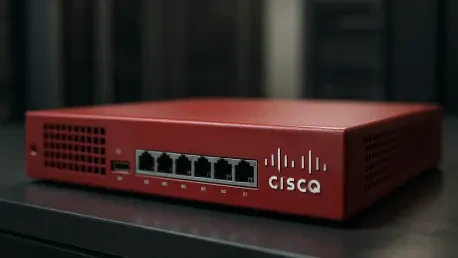Setting the Stage for Network Security Challenges
In an era where cyber threats loom larger than ever, with enterprise networks facing an average of over 500 attacks per day according to recent industry reports, the importance of robust firewall solutions cannot be overstated. Imagine a critical financial institution suddenly losing access to its core systems due to a remote attack exploiting a single unpatched vulnerability, a scenario that underscores the urgency for organizations to stay ahead of potential breaches, particularly when relying on widely used security platforms like Cisco’s Secure Firewall suite. This review delves into the latest bundled security updates from Cisco, released in August, addressing over 20 vulnerabilities across key products and reinforcing defenses against escalating cyber risks.
The focus of these updates spans the Secure Firewall Management Center (FMC), Secure Firewall Threat Defense (FTD), and Adaptive Security Appliance (ASA), all integral to protecting enterprise environments. With cyber attackers increasingly targeting network infrastructure, Cisco’s timely response to these vulnerabilities highlights a commitment to safeguarding critical systems. This analysis aims to unpack the specifics of the patches, evaluate their impact, and explore the broader implications for network security in a rapidly evolving threat landscape.
In-Depth Analysis of Features and Performance
Critical Vulnerability: Addressing CVE-2025-20265 in Secure FMC
At the heart of Cisco’s recent updates lies a critical flaw, identified as CVE-2025-20265, affecting the Secure FMC with RADIUS authentication enabled. This vulnerability stands out due to its potential for remote, unauthenticated attackers to execute arbitrary code, a severe risk that could compromise entire systems. The flaw stems from improper handling of user input during authentication, allowing high-privilege command execution that threatens system integrity.
The implications of such a vulnerability are profound, as it could enable attackers to gain unauthorized access to sensitive configurations or data. Cisco’s swift release of a patch for this issue demonstrates a proactive stance, though the urgency for IT teams to apply the fix cannot be understated. This critical update serves as a reminder of the high stakes involved in managing network security tools that control enterprise-wide defenses.
High-Severity Threats Across Multiple Platforms
Beyond the critical flaw, Cisco has tackled over a dozen high-severity vulnerabilities affecting FMC, FTD, and ASA products. A recurring concern among these issues is the risk of Denial of Service (DoS) attacks, many of which can be triggered by unauthenticated remote attackers, disrupting services without requiring prior access. Such vulnerabilities pose a direct threat to operational continuity, especially for organizations dependent on uninterrupted network availability.
Specific to FMC, additional high-severity flaws include risks like HTML injection, where authenticated attackers can insert malicious content into system-generated documents. Other concerns involve arbitrary file access on the operating system and Server-Side Request Forgery (SSRF) attacks, both of which could lead to significant breaches if exploited. These patches address complex attack vectors, showcasing Cisco’s efforts to fortify its platforms against multifaceted threats.
Medium-Severity Fixes and Broader Security Coverage
The update also includes patches for eleven medium-severity vulnerabilities across the affected products. While detailed public information on these issues remains limited, their inclusion in the comprehensive security bundle reflects Cisco’s thorough approach to risk mitigation. These fixes, though less severe, contribute to a more resilient ecosystem by closing potential entry points for attackers.
This layered strategy ensures that even lower-priority flaws do not become stepping stones for larger exploits. For organizations managing diverse Cisco deployments, understanding the scope of these medium-severity updates is essential to maintaining a holistic security posture. The availability of patches for all identified issues further aids in streamlining remediation efforts.
Trends and Real-World Impact on Enterprise Security
A prominent trend in this security update is the prevalence of remotely exploitable vulnerabilities that require no authentication, highlighting a persistent challenge in firewall protection. Such flaws emphasize the need for stringent configurations and rapid patch deployment to prevent exploitation before attackers can act. The cybersecurity community widely agrees on the importance of immediate action to counter these risks, as delays could expose networks to significant harm.
The real-world implications of these updates are particularly relevant for industries like finance, healthcare, and government, where Cisco’s firewall solutions protect sensitive data and critical operations. Unpatched systems in these sectors could lead to catastrophic disruptions, from financial losses to compromised patient records. Cisco’s provision of a software checker tool offers a practical resource for IT teams to identify vulnerable systems and apply fixes efficiently, minimizing downtime and exposure.
The broader context of evolving cyber threats also ties into unrelated incidents within Cisco’s ecosystem, such as recent attacks on the Identity Services Engine (ISE) shortly after patch releases. While not directly linked to firewall vulnerabilities, these events underscore the relentless nature of cyber adversaries targeting enterprise software. This dynamic environment necessitates constant vigilance and robust security practices beyond mere patching.
Challenges in Maintaining Firewall Integrity
One of the ongoing hurdles in securing firewall systems lies in managing remotely exploitable vulnerabilities across complex, distributed networks. Ensuring that all systems receive timely updates remains a logistical challenge, especially for large organizations with sprawling IT infrastructures. The risk of oversight or delayed deployment can leave critical gaps in defenses, amplifying exposure to potential attacks.
Additionally, the complexity of Cisco’s ecosystem introduces challenges in maintaining consistent security across diverse products and configurations. Even with patches available, the human element—ensuring awareness and execution—remains a weak link in the chain. This situation calls for enhanced training and automated update mechanisms to reduce the burden on IT staff and improve response times.
Looking at the bigger picture, the persistent evolution of cyber threats demands more than reactive measures. Organizations must adopt a proactive mindset, integrating regular audits and threat assessments into their security frameworks. While Cisco’s updates address current vulnerabilities, the challenge of anticipating future attack methods remains an ever-present concern for network administrators.
Looking Ahead: The Future of Cisco’s Security Solutions
As cyber threats continue to advance, Cisco’s future security enhancements are likely to focus on improved detection and prevention capabilities within its firewall offerings. Innovations such as machine learning-driven threat identification and automated response protocols could play a pivotal role in staying ahead of sophisticated attacks. These advancements would help mitigate risks before they materialize into full-blown breaches.
Customer feedback will also be instrumental in shaping Cisco’s roadmap for security updates over the coming years, potentially from this year to 2027. By addressing user-reported concerns and integrating real-world insights, Cisco can refine its solutions to better meet enterprise needs. This collaborative approach could strengthen trust in the brand as a reliable partner in network defense.
The long-term impact of such security measures will hinge on Cisco’s ability to balance innovation with usability, ensuring that complex protections do not hinder operational efficiency. As threats grow more intricate, the expectation for seamless integration of advanced security features into existing systems will shape the trajectory of Cisco’s market position. Staying responsive to these demands will be key to maintaining confidence in its enterprise solutions.
Final Thoughts and Next Steps
Reflecting on Cisco’s August security updates, the response to over 20 vulnerabilities, including the critical CVE-2025-20265 flaw in Secure FMC, marks a significant step in bolstering network defenses. The patches for high-severity DoS risks and other threats like HTML injection demonstrate a comprehensive effort to address diverse attack vectors. The absence of reported exploits at the time provides a crucial window for organizations to secure their systems without immediate pressure from active threats.
Moving forward, IT teams should prioritize the immediate application of these patches using Cisco’s software checker tool to identify and remediate affected systems efficiently. Beyond this, establishing automated update processes and conducting regular security audits can help prevent future vulnerabilities from lingering unnoticed. Collaboration between Cisco and its customers to share threat intelligence could further enhance proactive defenses.
As the cyber landscape continues to shift, exploring integrated security solutions that combine firewall protections with broader endpoint and cloud defenses offers a path to more resilient networks. Organizations must also invest in training staff to recognize and respond to emerging risks swiftly. These actionable steps, built on the foundation of Cisco’s latest updates, pave the way for stronger enterprise security in an increasingly hostile digital environment.









